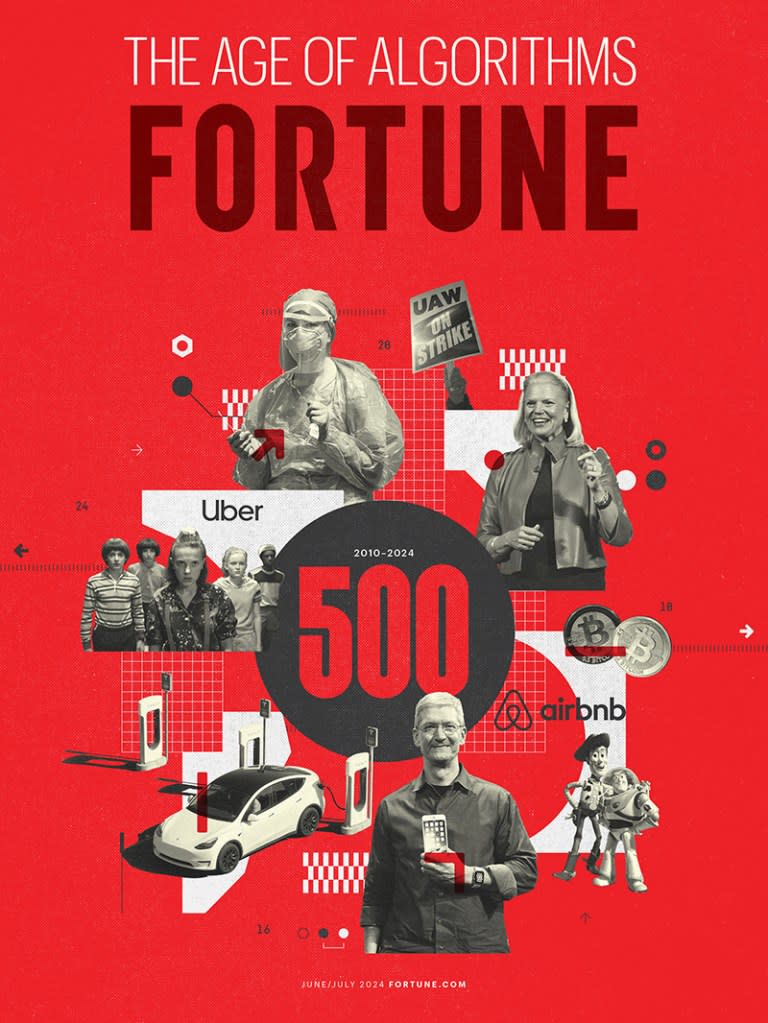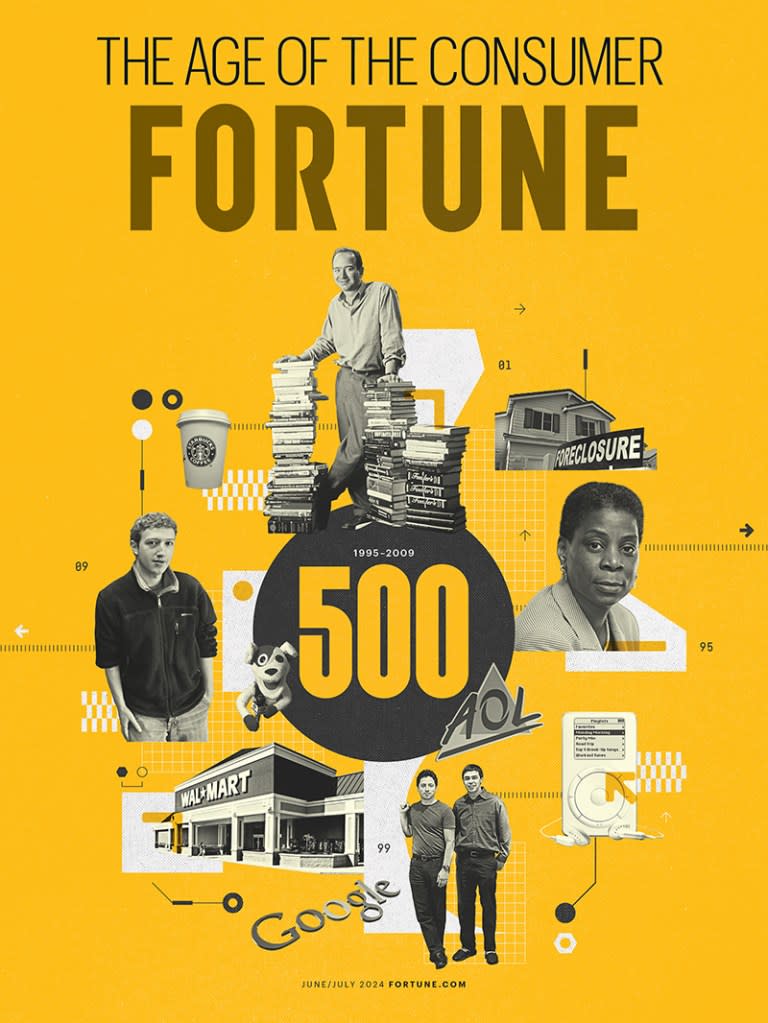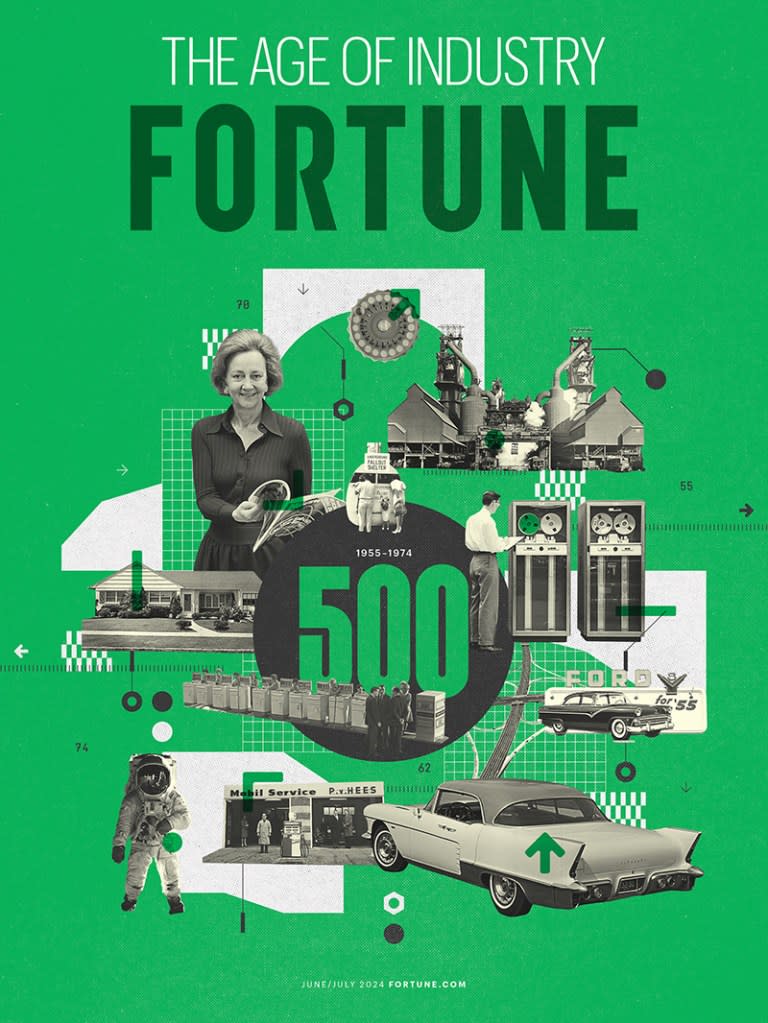The 70th edition of the Fortune 500 shows how the biggest businesses stay successful for decades
Almost 70 years ago, we published the first-ever Fortune 500 ranking of America’s largest corporations by revenue.
The business world looked a lot different then. America was in the midst of a manufacturing boom. Half of the world’s industrial output was produced by the U.S. The inaugural Fortune 500 recognized companies that contributed the most—“industrials” like oil producers, steelmakers, car companies, and meatpackers.
Today, American manufacturing still matters, but it’s a much smaller share of the economy. So now the Fortune 500—the world’s most authoritative business list—measures all industries. Retailers, banks, and tech and health care companies are the fastest-growing sectors in the business universe.
Only 49 of the original Fortune 500 companies remain on the list, but with a few exceptions they’ve aged well. And they’ve kept growing: In 1955 they generated $406 billion (measured in 2023 dollars); last year they brought in $2.4 trillion, led by giants like Exxon Mobil, General Motors, and Johnson & Johnson.
Staying big and successful for 70 years is no easy feat. The lifespan of most large companies is only a few decades. Perhaps you’ve heard of Jeff Bezos’s “day one” approach at Amazon: He believes that the moment a company enters “day two,” replacing rapid-fire innovation with complacency, it’s toast.
One company that has fought its way back from the day-two brink is Microsoft, No. 13 on this year’s Fortune 500. Ten years ago, the company felt dull, sluggish, and far from innovative. Steve Ballmer was exiting from an unremarkable tenure as CEO, and the company had a market cap well under $400 billion.
Staying big and successful for 70 years is no easy feat. The lifespan of most large companies is only a few decades.
Under Satya Nadella, Microsoft’s future has never looked brighter. He instilled a culture of “learn-it-alls” instead of “know-it-alls,” letting developer customers guide product iterations instead of foisting unwanted software on them. Nadella made bold acquisitions, like LinkedIn and GitHub, and placed big bets. While not all of them have panned out—the HoloLens mixed-reality headset, for example, was effectively shut down last year—one big wager has: generative AI.
Fortune’s Jeremy Kahn interviewed Nadella and followed him around Southeast Asia on a meet-the-customers tour to learn more about his transformative leadership style and mindset. Nadella told Kahn that what drives him is a constant fear of missing the next big thing. “When the paradigm shifts, do you have something to contribute?” Nadella said. “Because there is no God-given right to exist if you don’t have anything relevant.”
Also in this issue, you’ll read about how Costco (No. 11) keeps its edge. The secret sauce has been about very intentionally creating a cultlike fervor, through strategic product choices and a unique if sometimes confusing store experience that helps shoppers stumble across “treasure.”
Phil Wahba gently pried those secrets out of Costco’s C-suite. We hope you’ll find their tips, and lessons from other Fortune 500 CEOs, like Doug McMillon of No. 1 Walmart, applicable to your own business ambitions—whether your company is “industrial” or otherwise.
Alyson Shontell
Editor-in-Chief, Fortune
@ajs
The Fortune 500, curated by AI
For our special covers, information graphics director Nicolas Rapp quizzed a chatbot about key trends and people of the past 70 years; Mia Diehl, Alexandra Scimecca, and Jasmine Li gathered and researched images; artist Israel Vargas incorporated them into these designs.

2010–2024: The age of Algorithms and digital dominance
Apple’s iPhone and other smartphones put computers in the pockets of consumers everywhere. Digital know-how enables companies like Netflix and Disney’s Pixar to remake entertainment, and fuels Tesla’s dreams of self-driving cars. Utopian techies rally around cryptocurrencies like Bitcoin. But will a digital economy mean more inequality?

1995–2009: Consumers rule, and big tech is born
Consumer-driven chains like Walmart and Starbucks expand. Ursula Burns of Xerox is the first Black woman to become a Fortune 500 CEO. “Asset-light” tech firms revolutionize business: Some models fail (lookin’ at you, Pets.com), but Amazon, Facebook, and Google lay the foundations of empires. The Great Recession is a sobering coda.

1975–1994: Globalization and an economy in flux
America’s manufacturing dominance fades, but its global cultural footprint grows. Roberto Goizueta of Coca-Cola becomes the first Latino Fortune 500 CEO. Disney opens Epcot—globalization in theme-park form. Intel makes breakthroughs in chip miniaturization, and tech tinkerers like Apple’s Steve Jobs and Microsoft’s Bill Gates take note.

1955–1974: An industrial age, and a postwar boom
General Motors tops the first Fortune 500 list, as suburbanization and the auto industry grow together. General Electric fills those tract houses with appliances. IBM computers help send humanity to the moon. Legal birth control enables millions of women to start careers, and the Washington Post’s Katharine Graham becomes the 500’s first female CEO.
Cover illustrations by Israel G. Vargas.
Cover credits: 1955–1974: Getty Images (12) Marion S Trikosko/US News and World Report Collection/PhotoQuest; Jack Rosen; SSPL; Bettmann Archive; H. Armstrong Roberts/ClassicStock; Joe Wherry/The Enthusiast Network; Sepia Times/Universal Images Group; Heritage Space; Paul Walters Worldwide Photography Ltd./Heritage Images; George Marks/Retrofile. 1975–1994: Getty Images (8) BettmanN; Tom Munnecke; Jean Meunier; SSPL; Doug Wilson; Michael Tullberg; SSPL; Michel Baret/Gamma-Rapho. 1995–2009: Getty Images (9) Newscast/Universal Images Group; Paul Souders; Justin Sullivan; Norm Betts/Bloomberg; Courtesy of Apple; Patrick Durand/Sygma; Richard Koci Hernandez/San Jose Mercury News/MediaNews Group/The Mercury News; Gordon Chibroski/Portland Press Herald; Chris Hondros/Newsmakers. Google logo: Ben Margot—AP Photo; Zuckerberg: Paul Sakuma—AP Photo. 2010–2024: Getty Images (6) Noam Galai; Emily Elconin/Bloomberg; Ethan Miller; George Frey/Bloomberg; Justin Sullivan (2); Toy Story: Buena Vista Pictures/Everett Collection; Stranger Things: Netflix/Everett Collection
This article appears in the June/July 2024 issue of Fortune with the headline, "Seven decades of 'day-one' companies."
This story was originally featured on Fortune.com

 Yahoo Finance
Yahoo Finance 